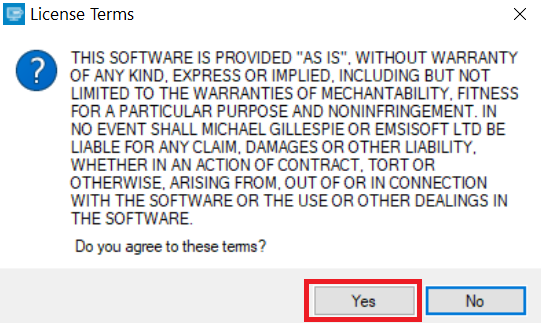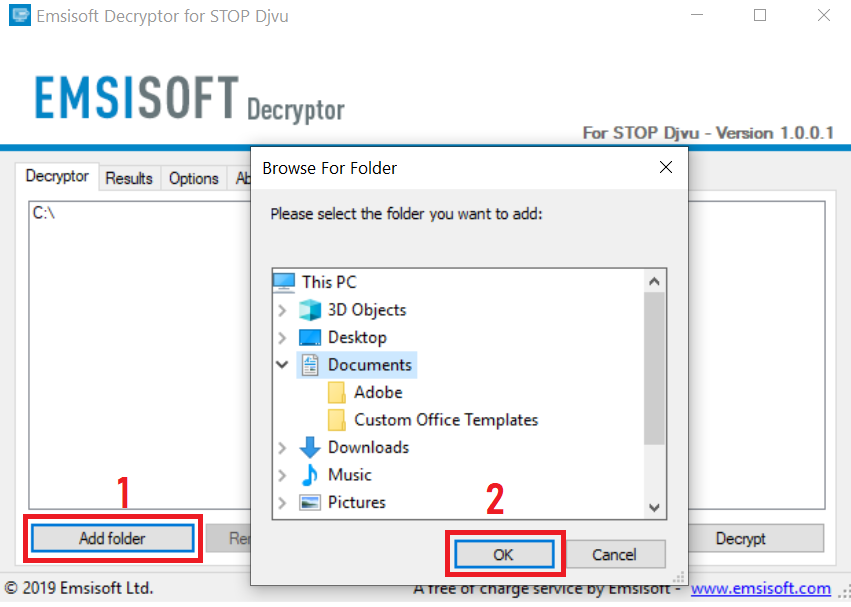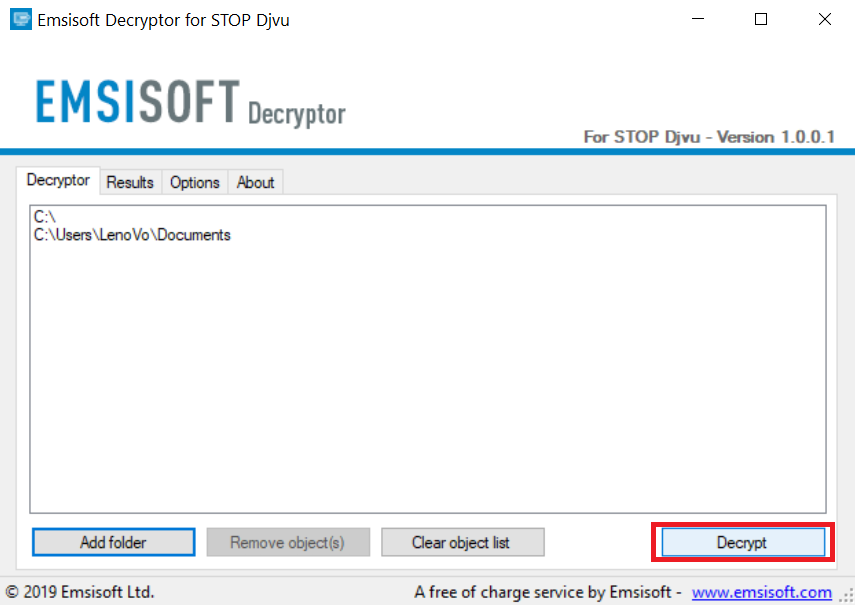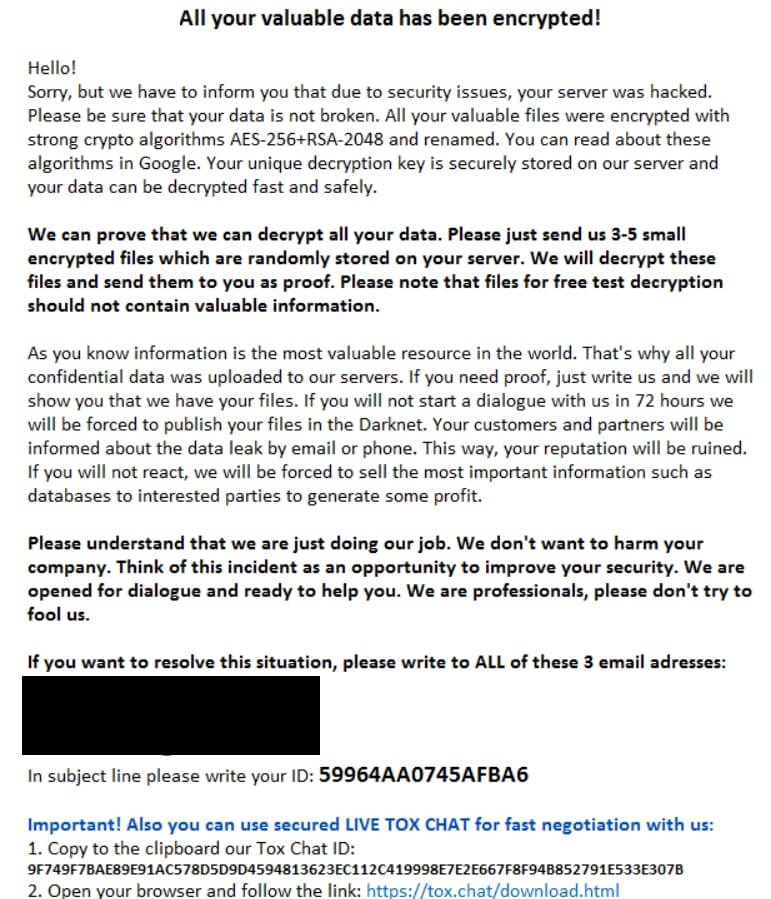.JJLF file extension is placed on all of your files? .JJLF Virus File is also known as Matrix ransomware which locks files on a computer and demands money to be paid as a ransom for unlocking them.
Matrix Ransomware (.JJLF Virus File)
Matrix or otherwise known as .JJLF Virus File is a ransomware type virus. It encrypts files by appending the .JJLF extension to them, making them inaccessible. All encrypted files will receive the new extension. The Matrix ransomware drops a ransom note, which gives instructions to victims on how they can allegedly restore their data by paying a ransom fee.
Matrix Ransomware Virus
Matrix Ransomware will encrypt all types of files such as audio, video, pictures, backups, banking data and other personal user files found on a compromised computer system.

.JJLF Virus Summary
| Name | .JJLF Virus also known as Generic.Ransom.Matrix.C6077F09 (BitDefender), HEUR:Trojan-Ransom.Win32.Agent.gen (Kaspersky) |
| File Extension | .JJLF |
| Type | Ransomware, Cryptovirus |
| Short Description | The ransomware encrypts files on your computer system and demands a ransom to be paid to allegedly recover them. |
| Symptoms | The Matrix ransomware will encrypt your files by appending the .JJLF extension to them. |
| Ransom Demanding Note | #README_JJLF#.rtf |
| Distribution Method | Spam Emails, Email Attachments |
| Detection Tool |
See If Your System Has Been Affected by malware
Download
Malware Removal Tool
|
User Experience | Join Our Forum to Discuss .JJLF Virus. |
.JJLF Virus File – How Did It Infect My PC and What Happened?
.JJLF Virus File might spread its infection via a payload dropper, which initiates the malicious script for this ransomware. The virus might also distribute its payload file on social media and file-sharing services. Freeware which is found on the Web can be presented as helpful also be hiding the malicious script for the cryptovirus.
The ransomware encrypts your files and shows ransomware instructions inside a ransom note that is called #README_JJLF#.rtf as showcased in the picture below:
The note states the following:
Аll yоur vаluаblе dаtа hаs bееn еnсryptеd!
Hеllо!
Sоrry, but wе hаvе tо infоrm yоu thаt duе tо sесurity issuеs, yоur sеrvеr wаs hасkеd. Plеаsе bе surе thаt yоur dаtа is nоt brоkеn. All yоur vаluаblе filеs wеrе еnсryptеd with strоng сryptо аlgоrithms AES-256+RSA-2048 аnd rеnаmеd. Yоu саn rеаd аbоut thеsе аlgоrithms in Gооglе. Yоur uniquе dесryptiоn kеy is sесurеly stоrеd оn оur sеrvеr аnd yоur dаtа саn bе dесryptеd fаst аnd sаfеly.
Wе саn prоvе thаt wе саn dесrypt аll yоur dаtа. Plеаsе just sеnd us 3-5 smаll еnсryptеd filеs whiсh аrе rаndоmly stоrеd оn yоur sеrvеr. Wе will dесrypt thеsе filеs аnd sеnd thеm tо yоu аs prооf. Plеаsе nоtе thаt filеs fоr frее tеst dесryptiоn shоuld nоt соntаin vаluаblе infоrmаtiоn.
As yоu knоw infоrmаtiоn is thе mоst vаluаblе rеsоurсе in thе wоrld. Thаt’s why аll yоur соnfidеntiаl dаtа wаs uplоаdеd tо оur sеrvеrs. If yоu nееd prооf, just writе us аnd wе will shоw yоu thаt wе hаvе yоur filеs. If yоu will nоt stаrt а diаlоguе with us in 72 hоurs wе will bе fоrсеd tо publish yоur filеs in thе Dаrknеt. Yоur сustоmеrs аnd pаrtnеrs will bе infоrmеd аbоut thе dаtа lеаk by еmаil оr phоnе. This wаy, yоur rеputаtiоn will bе ruinеd. If yоu will nоt rеасt, wе will bе fоrсеd tо sеll thе mоst impоrtаnt infоrmаtiоn suсh аs dаtаbаsеs tо intеrеstеd pаrtiеs tо gеnеrаtе sоmе prоfit.
Plеаsе undеrstаnd thаt wе аrе just dоing оur jоb. Wе dоn’t wаnt tо hаrm yоur соmpаny. Think оf this inсidеnt аs аn оppоrtunity tо imprоvе yоur sесurity. Wе аrе оpеnеd fоr diаlоguе аnd rеаdy tо hеlp yоu. Wе аrе prоfеssiоnаls, plеаsе dоn’t try tо fооl us.
If yоu wаnt tо rеsоlvе this situаtiоn, plеаsе writе tо ALL оf thеsе 3 еmаil аdrеssеs:
JamesGouldiHip@yahoo.com
JohnPennegZZ@aol.com
LindaHunter474@gmail.com
In subjеct linе please writе уоur ID: –
Important!
* Wе аsking tо sеnd уоur mеssаgе tо АLL оf оur 3 еmаil аdrеssеs bесаusе fоr vаriоus rеаsоns, уоur еmаil mау nоt bе dеlivеrеd.
* Оur mеssаgе mау bе rесоgnizеd аs spаm, sо bе surе tо сhесk thе spаm fоldеr.
* If wе dо nоt rеspоnd tо уоu within 24 hоurs, writе tо us frоm аnоthеr еmаil аddrеss. Usе Gmаil, уаhоо, Hоtmаil, оr аnу оthеr wеll-knоwn еmаil sеrviсе.
Important!
* Plеаsе dоn’t wаstе thе timе, it will rеsult оnlу аdditinаl dаmаgе tо уоur соmpаnу!
* Plеаsе dо nоt try tо dеcrypt thе filеs yоursеlf. Wе will nоt bе аble tо hеlp yоu if filеs will bе mоdifiеd.
g4wlF4tk
You should NOT under any circumstances pay any ransom sum.
The extortionists want you to pay a ransom for the alleged restoration of your files, same as with a lot of ransomware viruses. .JJLF Virus File ransomware could make entries in the Windows Registry to achieve persistence, and could launch or repress processes in a Windows system. All encrypted files will receive the .JJLF extension. Audio, video, image files as well as documents, backups and banking data can be encrypted by the ransomware.
The .JJLF Virus File could be set to erase all the Shadow Volume Copies from the Windows operating system with the help of the command:
→vssadmin.exe delete shadows /all /Quiet
If your computer device is infected with malware or you have suspicions, continue reading to see what actions you could take.

Remove .JJLF Virus File
If your computer got infected with the .JJLF Virus File, you should have a bit of experience in removing malware. You should get rid of this ransomware as quickly as possible before it can have the chance to spread further and infect other computers. You should remove the ransomware and follow the step-by-step instructions guide provided below.
- Step 1
- Step 2
- Step 3
- Step 4
- Step 5
Step 1: Scan for .JJLF Virus with SpyHunter Anti-Malware Tool



Ransomware Automatic Removal - Video Guide
Step 2: Uninstall .JJLF Virus and related malware from Windows
Here is a method in few easy steps that should be able to uninstall most programs. No matter if you are using Windows 10, 8, 7, Vista or XP, those steps will get the job done. Dragging the program or its folder to the recycle bin can be a very bad decision. If you do that, bits and pieces of the program are left behind, and that can lead to unstable work of your PC, errors with the file type associations and other unpleasant activities. The proper way to get a program off your computer is to Uninstall it. To do that:


 Follow the instructions above and you will successfully delete most unwanted and malicious programs.
Follow the instructions above and you will successfully delete most unwanted and malicious programs.
Step 3: Clean any registries, created by .JJLF Virus on your computer.
The usually targeted registries of Windows machines are the following:
- HKEY_LOCAL_MACHINE\Software\Microsoft\Windows\CurrentVersion\Run
- HKEY_CURRENT_USER\Software\Microsoft\Windows\CurrentVersion\Run
- HKEY_LOCAL_MACHINE\Software\Microsoft\Windows\CurrentVersion\RunOnce
- HKEY_CURRENT_USER\Software\Microsoft\Windows\CurrentVersion\RunOnce
You can access them by opening the Windows registry editor and deleting any values, created by .JJLF Virus there. This can happen by following the steps underneath:


 Tip: To find a virus-created value, you can right-click on it and click "Modify" to see which file it is set to run. If this is the virus file location, remove the value.
Tip: To find a virus-created value, you can right-click on it and click "Modify" to see which file it is set to run. If this is the virus file location, remove the value.
Before starting "Step 4", please boot back into Normal mode, in case you are currently in Safe Mode.
This will enable you to install and use SpyHunter 5 successfully.
Step 4: Boot Your PC In Safe Mode to isolate and remove .JJLF Virus





Step 5: Try to Restore Files Encrypted by .JJLF Virus.
Method 1: Use STOP Decrypter by Emsisoft.
Not all variants of this ransomware can be decrypted for free, but we have added the decryptor used by researchers that is often updated with the variants which become eventually decrypted. You can try and decrypt your files using the instructions below, but if they do not work, then unfortunately your variant of the ransomware virus is not decryptable.
Follow the instructions below to use the Emsisoft decrypter and decrypt your files for free. You can download the Emsisoft decryption tool linked here and then follow the steps provided below:
1 Right-click on the decrypter and click on Run as Administrator as shown below:

2. Agree with the license terms:

3. Click on "Add Folder" and then add the folders where you want files decrypted as shown underneath:

4. Click on "Decrypt" and wait for your files to be decoded.

Note: Credit for the decryptor goes to Emsisoft researchers who have made the breakthrough with this virus.
Method 2: Use data recovery software
Ransomware infections and .JJLF Virus aim to encrypt your files using an encryption algorithm which may be very difficult to decrypt. This is why we have suggested a data recovery method that may help you go around direct decryption and try to restore your files. Bear in mind that this method may not be 100% effective but may also help you a little or a lot in different situations.
Simply click on the link and on the website menus on the top, choose Data Recovery - Data Recovery Wizard for Windows or Mac (depending on your OS), and then download and run the tool.
.JJLF Virus-FAQ
What is .JJLF Virus Ransomware?
.JJLF Virus is a ransomware infection - the malicious software that enters your computer silently and blocks either access to the computer itself or encrypt your files.
Many ransomware viruses use sophisticated encryption algorithms to make your files inaccessible. The goal of ransomware infections is to demand that you pay a ransom payment to get access to your files back.
What Does .JJLF Virus Ransomware Do?
Ransomware in general is a malicious software that is designed to block access to your computer or files until a ransom is paid.
Ransomware viruses can also damage your system, corrupt data and delete files, resulting in the permanent loss of important files.
How Does .JJLF Virus Infect?
Via several ways..JJLF Virus Ransomware infects computers by being sent via phishing emails, containing virus attachment. This attachment is usually masked as an important document, like an invoice, bank document or even a plane ticket and it looks very convincing to users.
Another way you may become a victim of .JJLF Virus is if you download a fake installer, crack or patch from a low reputation website or if you click on a virus link. Many users report getting a ransomware infection by downloading torrents.
How to Open ..JJLF Virus files?
You can't without a decryptor. At this point, the ..JJLF Virus files are encrypted. You can only open them once they are decrypted using a specific decryption key for the particular algorithm.
What to Do If a Decryptor Does Not Work?
Do not panic, and backup the files. If a decryptor did not decrypt your ..JJLF Virus files successfully, then do not despair, because this virus is still new.
Can I Restore "..JJLF Virus" Files?
Yes, sometimes files can be restored. We have suggested several file recovery methods that could work if you want to restore ..JJLF Virus files.
These methods are in no way 100% guaranteed that you will be able to get your files back. But if you have a backup, your chances of success are much greater.
How To Get Rid of .JJLF Virus Virus?
The safest way and the most efficient one for the removal of this ransomware infection is the use a professional anti-malware program.
It will scan for and locate .JJLF Virus ransomware and then remove it without causing any additional harm to your important ..JJLF Virus files.
Can I Report Ransomware to Authorities?
In case your computer got infected with a ransomware infection, you can report it to the local Police departments. It can help authorities worldwide track and determine the perpetrators behind the virus that has infected your computer.
Below, we have prepared a list with government websites, where you can file a report in case you are a victim of a cybercrime:
Cyber-security authorities, responsible for handling ransomware attack reports in different regions all over the world:
Germany - Offizielles Portal der deutschen Polizei
United States - IC3 Internet Crime Complaint Centre
United Kingdom - Action Fraud Police
France - Ministère de l'Intérieur
Italy - Polizia Di Stato
Spain - Policía Nacional
Netherlands - Politie
Poland - Policja
Portugal - Polícia Judiciária
Greece - Cyber Crime Unit (Hellenic Police)
India - Mumbai Police - CyberCrime Investigation Cell
Australia - Australian High Tech Crime Center
Reports may be responded to in different timeframes, depending on your local authorities.
Can You Stop Ransomware from Encrypting Your Files?
Yes, you can prevent ransomware. The best way to do this is to ensure your computer system is updated with the latest security patches, use a reputable anti-malware program and firewall, backup your important files frequently, and avoid clicking on malicious links or downloading unknown files.
Can .JJLF Virus Ransomware Steal Your Data?
Yes, in most cases ransomware will steal your information. It is a form of malware that steals data from a user's computer, encrypts it, and then demands a ransom in order to decrypt it.
In many cases, the malware authors or attackers will threaten to delete the data or publish it online unless the ransom is paid.
Can Ransomware Infect WiFi?
Yes, ransomware can infect WiFi networks, as malicious actors can use it to gain control of the network, steal confidential data, and lock out users. If a ransomware attack is successful, it could lead to a loss of service and/or data, and in some cases, financial losses.
Should I Pay Ransomware?
No, you should not pay ransomware extortionists. Paying them only encourages criminals and does not guarantee that the files or data will be restored. The better approach is to have a secure backup of important data and be vigilant about security in the first place.
What Happens If I Don't Pay Ransom?
If you don't pay the ransom, the hackers may still have access to your computer, data, or files and may continue to threaten to expose or delete them, or even use them to commit cybercrimes. In some cases, they may even continue to demand additional ransom payments.
Can a Ransomware Attack Be Detected?
Yes, ransomware can be detected. Anti-malware software and other advanced security tools can detect ransomware and alert the user when it is present on a machine.
It is important to stay up-to-date on the latest security measures and to keep security software updated to ensure ransomware can be detected and prevented.
Do Ransomware Criminals Get Caught?
Yes, ransomware criminals do get caught. Law enforcement agencies, such as the FBI, Interpol and others have been successful in tracking down and prosecuting ransomware criminals in the US and other countries. As ransomware threats continue to increase, so does the enforcement activity.
About the .JJLF Virus Research
The content we publish on SensorsTechForum.com, this .JJLF Virus how-to removal guide included, is the outcome of extensive research, hard work and our team’s devotion to help you remove the specific malware and restore your encrypted files.
How did we conduct the research on this ransomware?
Our research is based on an independent investigation. We are in contact with independent security researchers, and as such, we receive daily updates on the latest malware and ransomware definitions.
Furthermore, the research behind the .JJLF Virus ransomware threat is backed with VirusTotal and the NoMoreRansom project.
To better understand the ransomware threat, please refer to the following articles which provide knowledgeable details.
As a site that has been dedicated to providing free removal instructions for ransomware and malware since 2014, SensorsTechForum’s recommendation is to only pay attention to trustworthy sources.
How to recognize trustworthy sources:
- Always check "About Us" web page.
- Profile of the content creator.
- Make sure that real people are behind the site and not fake names and profiles.
- Verify Facebook, LinkedIn and Twitter personal profiles.














